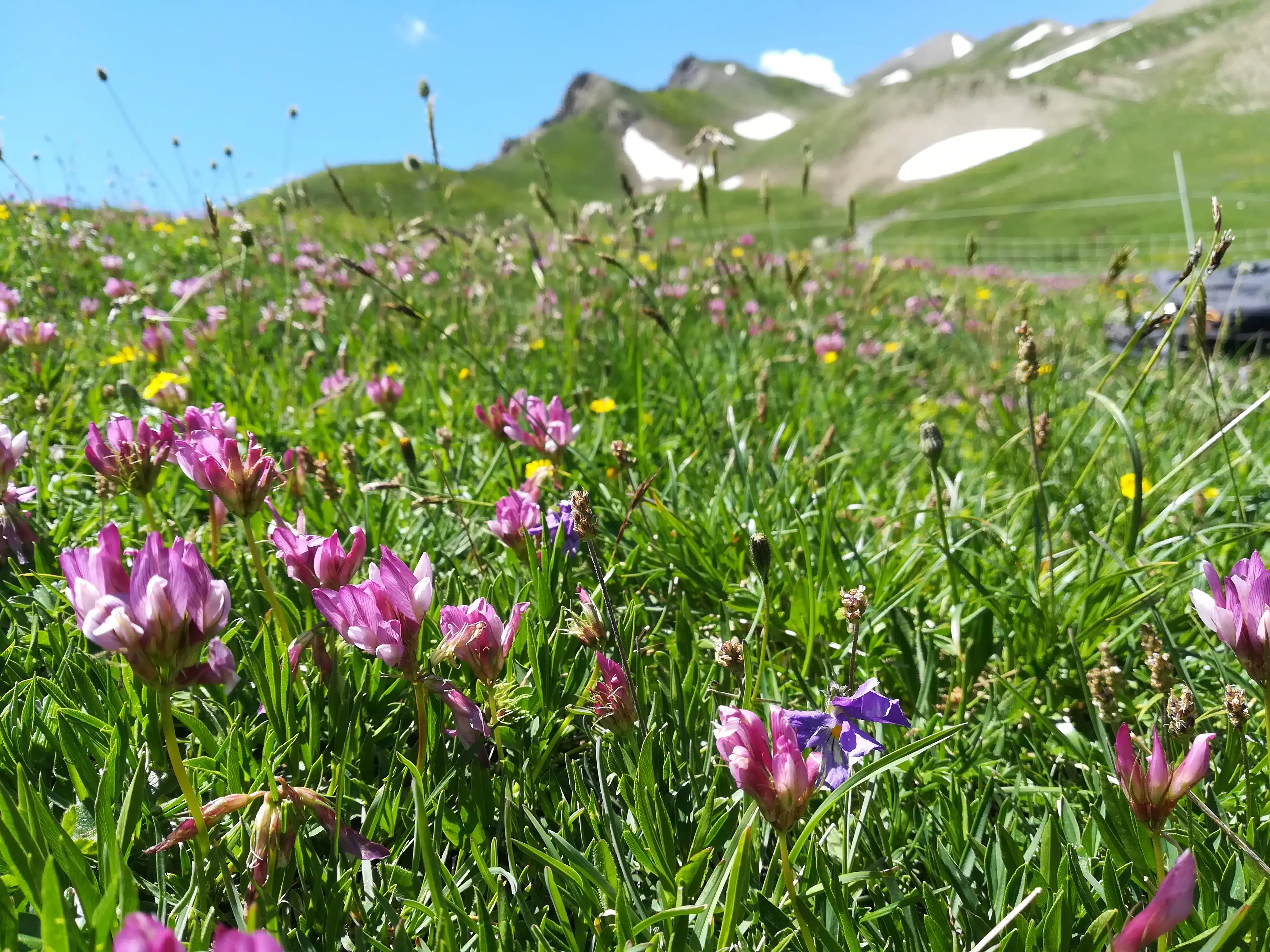We ranked her in our TOP 100 people to follow in 2022. Interview with Billur Bektaş who has just completed her thesis at the University of Grenoble on the project « Flying Meadows », these high altitude plants which also suffer from global warming. We talk with her about this unique experiment conducted at the Jardin du Lautaret and the more recent results.
Why is it important to study alpine plants ?
Billur Bektas: In the context of global warming, mountains are particularly vulnerable. Not only because they are the biodiversity hotspot and they have manyn ecosystem contributions to people, for example agricultural activities, grazing activities and carbon storage.
Mountains are particularly vulnerable also because global warming is accelerated in the mountains there. The rate of increase of the global surface temperature rises by 0,2 degree per decade, whereas in the mountains it is around 0.3 degree per decade. In fact, in the mountains, climate warming brings various changes: for example earlier snowmelt, more early-spring freezing events and more frequent and intense droughts. So plants are exposed to a completely new conditions.
We also have to think about the geometry of the mountain, sort of conical shaped. So, some plants are migrating from the foothill to the mountain tops because they like cooler temperatures and therefore climb to seek cooler conditions. Imagine it as the people of Grenoble do during the summer heatwaves who escape to the mountains during summer heatwaves. However, alpine plants that are already at the mountain tops cannot go anywhere as the mountains have their limits. So these plants are at the crossfires ! They are suffering from climate warming and they need to share their habitat with the new species that arrive from the lower altitudes. This is why we need to study these plants better under climate warming.
We simulated A WARmer climate (THREE DEGREES) ON high altitude Alpine plants
So how do you study the changes of alpine plants under climate warming?
To understand what the future holds for these plants, we need to simulate first climate warming on them and second the arrival of these lowland species. It is for these reasons that we, the Alpine Ecology Laboratory, have set up the experiment « Flying Meadows » at the Col du Lautaret in 2016*. We transplanted one square meter alpine communities with 20cm of their soils from high altitude cold conditions to low altitude warmer conditions. Thanks to this setup, we warmed these plant communities together with their soil micro-organisms by 3°C. Besides, now that they are at a subalpine site, they are exposed to new subalpine species that can migrate in these experimentally warmed communities. So, it is important to understand how climate warming affects alpine plants and if they can be out-competed by these subalpine species.
We have been measuring the responses of plants, micro-organisms, soil nutrients and its moisture, etc. for the past 6 years. In 2021, we have replicated this experiment in the same area as well as in Alpe d’Huez, to see if there are regional differences in the effects we have observed.
How do these little ecosystems change under experimental warming ?
During my thesis, we mainly focused on plants. One of the first scientific papers I wrote was on understanding how climate warming changes the plant growth and the reproductive performance of these alpine species. For this, we tracked the plant growth, duration of flowering and number of individuals that can flower over three years for 6 different dominant species.
Surprisingly, we found that grasses and forbs were affected differently. While forbs decreased in their flowering performance, grasses were not affected. This could mean that we are losing all those beautiful colorful forb species. Overall, the plant growth increased under warming but the subalpine plants were still performing better than warmed alpine communities. This means that if these subalpine species migrate up in the future, they might outcompete alpine species under warming.
There are more losing alpine species than Winning ones
from global warming
What could be the consequences of the negative impacts on these forbs?
Well, forb species are important for pollinators. We also found out that when warmed, alpine plants attract less diverse pollinators, especially in comparison to subalpine species. So, the changes in plants cascade already to pollinators.
Do we already know the winner and loser species?
These results are very preliminary at the moment and we need to wait a bit more to understand the long-term responses. However, short-term responses are also very valuable to be able to conserve these species before it is too late. So, after 5 years of warming, we looked at all the species in these communities, 43 species in total… We tried to understand whether the number of individuals was decreasing or increasing, because that would help us understand whether there are more winners or losers under climate warming. Of Among these 43 species, 26 were losers and 17 were winners. Although the numbers may vary because the results are just preliminary, the key message is that there are more losers than winners. And when these species lose, they lose more than the winning winner species gain!
What does this mean?
Even though there are winner species, their gains are only on average 0.95% of their relative abundances (i.e. the number of individuals compared to the total number of individuals in the community). But when these species lose, they lose on average 2.50% of their relative abundances.
Do you already know how the soil nutrients and microorganisms react to experimental warming?
For now, we know that there is an increase in decomposition rates and a slight increase in bacterial biomass under warming. This means that the nutrient cycles are faster in these little ecosystems under warming. However, we do not know if these changes will further feedback to plants and create a domino effect.
I read that you are now developing a model to anticipate changes in alpine biodiversity according to the intensity of global warming?
I have just finished my doctoral thesis on Flying Meadows and I am starting to work at INRAE in Grenoble. The model you are talking about is a biodiversity model developed at the Laboratoire d’écologie Alpine long before me. I will use it in my work and potentially add other modules. It’s quite complicated to unravel the interactions between plants and their soils, so we need a biodiversity model to decipher these mechanisms and understand how they feedback each other.
Once we are more advanced on the issue, we will use this model to project these plant communities into the future. This will allow us to predict in some way the challenges that these plants will face in the context of accelerating global warming.
* Experiment « Flying Meadows » done with the collaboration of Jardin du Lautaret, INRAE-LESSEM, CARRTEL and EDYTEM research units. This highly collaborative experiment is managed and coordinated by Dr. Tamara Münkemüller and financed by ANR (Agence Nationale de la Recherche). To know more about it.
Read the research article written by Billur Bektaş.




